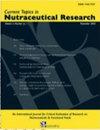The Perception of Snack Healthiness and Preferences in Children is Related to Health Parameter Measures
IF 0.4
4区 医学
Q4 NUTRITION & DIETETICS
Current Topics in Nutraceutical Research
Pub Date : 2022-05-04
DOI:10.37290/ctnr2641-452x.20m:m30-m37
引用次数: 0
Abstract
The relationship between snack preferences/healthiness and health parameters is still poorly defined. Most children choose snacks low in nutritional value, which may contribute to the rise in childhood obesity. This study has examined children’s snack preferences and healthiness by age and gender and correlated them with their health parameters. Scottish Nursery and Primary children aged 3–12 years (n = 472) performed snack card sorting exercises in which they were presented with 18 different colored snack images, which counted as one portion, followed by two main snack questions related to snack healthiness and preferences. Health parameters were measured. Older children were better able to determine which snacks were healthier based on their energy content. Children with a higher body mass index percentile were not found to have a specific preference for unhealthy snacks based on the four nutritional components. However, snacks high in fat and sugar (and low in energy and salt) were preferred by children with higher body fat. A positive relationship was observed between the energy content of the children’s top five snacks selected for healthiness and their weight, waist circumference, hip circumference, waist-to-hip ratio, and waist-to-height ratio. There was only a negative relationship with height and body fat. The relationship between children’s perceptions of snack preferences and healthiness and their health parameters is still unclear and needs further investigation.儿童对零食健康的感知和偏好与健康参数测量有关
零食偏好/健康与健康参数之间的关系仍然定义不清。大多数儿童选择营养价值低的零食,这可能会导致儿童肥胖的增加。本研究考察了不同年龄和性别儿童的零食偏好与健康状况,并将其与健康参数联系起来。472名3-12岁的苏格兰幼儿园和小学儿童(n = 472)进行了零食卡片分类练习,其中向他们展示了18种不同颜色的零食图像,这些图像被视为一份,然后是与零食健康和偏好相关的两个主要零食问题。测量了健康参数。年龄较大的孩子能够更好地根据其能量含量来确定哪种零食更健康。根据四种营养成分,没有发现身体质量指数百分位数较高的儿童对不健康零食有特定的偏好。然而,高脂肪和高糖(低能量和低盐)的零食更受体脂较高的儿童的青睐。儿童健康选择前五种零食的能量含量与体重、腰围、臀围、腰臀比、腰高比呈显著正相关。与身高和体脂只有负相关。儿童零食偏好感知与健康及其健康参数之间的关系尚不清楚,需要进一步研究。
本文章由计算机程序翻译,如有差异,请以英文原文为准。
求助全文
约1分钟内获得全文
求助全文
来源期刊
CiteScore
1.10
自引率
0.00%
发文量
36
审稿时长
>12 weeks
期刊介绍:
Current Topics in Nutraceutical Research is an international, interdisciplinary broad-based peer reviewed scientific journal for critical evaluation of research on chemistry, biology and therapeutic applications of nutraceuticals and functional foods. The major goal of this journal is to provide peer reviewed unbiased scientific data to the decision makers in the nutraceutical and food industry to help make informed choices about development of new products.
To this end, the journal will publish two types of review articles. First, a review of preclinical research data coming largely from animal, cell culture and other experimental models. Such data will provide basis for future product development and/or human research initiatives. Second, a critical evaluation of current human experimental data to help market and deliver the product for medically proven use. This journal will also serve as a forum for nutritionists, internists, neurologists, psychiatrists, and all those interested in preventive medicine.
The common denominator of all of the topic to be covered by the journal must include nutraceuticals and/functional food. The following is an example of some specific areas that may be of interest to the journal. i) Role of vitamins, minerals, antioxidants and phytonutrients on cardiovascular health, cancer, diabetes, ocular health, mental health, men’s health, women’s health, infant nutrition, ii) Role of herbals on human health, iii) Dietary supplements and sleep, iv) Components of diet that may have beneficial effect on human health, v) regulation of apoptosis and cell viability, vi) Isolation and characterization of bioactive components from functional foods, vii) Nutritional genomics, and viii) Nutritional proteomics.

 求助内容:
求助内容: 应助结果提醒方式:
应助结果提醒方式:


